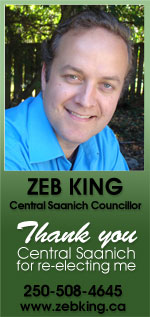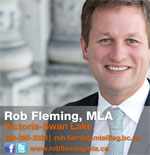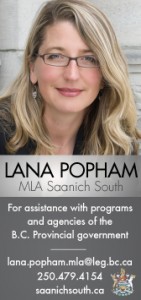Democracy, North Saanich Style
by Ross Campbell
“I encourage all citizens to attend North Saanich council meetings and to play a part in our democracy,” writes North Saanich Councillor Craig Mearns in a letter to the editor in the Peninsula News Review of February 20 2014.
Apparently the invitation does not extend to all citizens, as local resident Springfield Harrison recently found out. At issue was the presentation of a professional report by University of Victoria professor, Dr. Brock Smith on the merits of the recent North Saanich Housing Strategy Implementation Plan (HSIP). Mr. Harrison was struck from the agenda with statements such as “I don’t care what Mr. Harrison says,” from Councillor Dunstan Browne.
Councillor Ted Daly initiated the motion, supported by Councillors Brown, Mearns, and McBride, overruling Mayor Alice Finall’s plea to respect a basic right guaranteed all citizens. But this was only one act in a multi-act play being performed for the benefit of those who take an interest in such affairs in the council chambers.
The HSIP got its start early in 2012, when CTQ Consultants of Kelowna was retained at a cost of $ 16,800 to initiate a process of public consultation related to the prospect of possibly introducing higher density housing in the District. The Terms of Reference state that “the District is taking a proactive approach to identify and address local housing needs.” In fact, housing needs had been on the radar since at least 2007 when the District decided on public meetings to allow residents to opine about potential higher density housing.
In its report then, CitySpaces Consulting Ltd. noted that there was strong support for keeping North Saanich’s rural landscape intact. Therefore it recommended secondary suites and secondary dwellings be considered, along with recognition of locations where “smaller lots and multi-family housing would be acceptable…preferably in the form of dwelling units affordable to moderate income households.” This “moderate income” was defined in 2008 as a family with an income between $70 to $90,000 annually. Affordable housing became “rental or ownership housing that is attainable by a household without spending more than 30% of their annual gross income on housing.”
Further it stated, “A North Saanich couple family earning $91,099 (median income 2007) can afford to pay $ 2,429 monthly on housing without spending more than 32% of their income. At this income, the couple could afford to purchase a home of $453,390, assuming a 10% down payment.” A single income worker with a median annual income of $35,500 was limited to a purchase price of $177,000. These figures have not changed much in the intervening years, according to CMHC and TD Bank figures in the later CTQ report.
With a population of 11,000, it is important to note that the public input consisted of three information sessions attended by between 25 to 40 people, and similar numbers were contacted by telephone, attended the open house, or the community workshop. “The participation level was similar to housing strategy processes in other communities,” the report stated.
Fast forward to 2012 and yet another consultant, CTQ, hired for the task of identifying “housing needs and community values.” Again stakeholder focus groups, a public open house town hall type meeting as well as an ‘exit’ survey were used to gauge public sentiment during the first three months of the year. The report recognized the need to “balance these new dynamics (growing industrial hub, diverse employment node, growing ferry terminal, more highway traffic and pressures for development) while maintaining a community character for future generations to enjoy.” And, “the agricultural land base (ALR) and farming area helps define what North Saanich is all about for many residents,” leading the consultant to repeatedly describe ALR land as “sacrosanct.” Protection of property values and the environment were also strong considerations. In spite of this the Sandown Racetrack lands were suggested for comprehensive development because, it stated, “although these values are important, they must be considered in unison with other planning principles…” The complete report is at: http://tinyurl.com/oguz93o.
By the time this was completed, the consultant’s bill to the taxpayers for this exercise had risen to over $68,000.
Several professional responses to this report came from the public-at no cost to the District. The first, written by Dr. Natasha Caverley in September, 2013, was accepted without discussion by council. Her remarks questioned the vagueness of terminology and the use of terms, such as “anti-higher density” to seemingly cast aspersions on groups of residents. As well, “a series of statements, often provocative in nature, are noted in the HSIP final report without any source material referenced/cited,” Dr. Caverley adds. The complete letter can be read here: http://tinyurl.com/caverley.
Dr. Brock Smith, Professor of Marketing & Entrepreneurship at UVic’s Peter B. Gustavson School of Business, and CEO of Cordova Bay Consulting Ltd. was asked by Mr. Harrison and a group of concerned citizens to “assess the validity of the HSIP Exit Survey.” Dr. Smith has done similar survey-based research for Tourism Victoria, the Victoria Airport Authority, Clipper Navigation, among others.
In his critique, Dr. Smith also took issue with the limited numbers sampled, “The sampling approach was, at best, a convenience sample…the weakest samples from a perspective of representativeness….It would be inappropriate to generalize findings beyond the sample.”
He concludes with, “In my opinion, this convenience nature of the sample, and significant limitations in the question wording and measurement scales (answer choices) in this particular [exit] survey warrants significant caution in making key administrative or policy decisions based on the results of this survey.” The entire document can be found here. http://tinyurl.com/ok2t9ua.
In his letter of March 3rd, Mr. Harrison takes certain council members to task. “There is ample evidence that your group has no interest in a level playing field when it comes to public discussion…..Section 8 of the Procedures Bylaw requires [council members] ‘to consider the well-being and interests of the District and its community.’ Shutting down free expression does not align with this directive.” He adds, ‘this evaluation leaves the HSIP process, its recommendations and conclusions and all policies flowing from them, resting upon a very weakened foundation.” The complete letter can be found here: http://tinyurl.com/oen5g37.















Excellent article Mr. Campbell. I appreciated the objective way you let representatives speak for themselves. In that process it became vividly clear what the democratic versus self-interested positions were.
It’s quite amusing that the Kelowna consultant’s report presents the HSIP policy as equitable and sustainable–while dropping in the term “Sandown” more than 10 times. They infer Sandown is a minor departure from the North Saanich plan.
Sad.